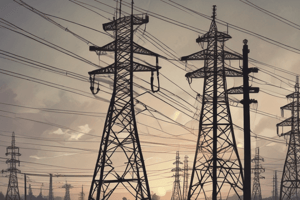Podcast
Questions and Answers
Which of the following is a primary function of a main distribution board (MDB) in an electrical system?
Which of the following is a primary function of a main distribution board (MDB) in an electrical system?
- To provide backup power in case of utility grid failure.
- To supply power directly to specific equipment.
- To regulate the voltage levels of individual circuits.
- To receive incoming power and distribute it to sub-circuits. (correct)
What is the main purpose of earthing (grounding) systems in electrical installations?
What is the main purpose of earthing (grounding) systems in electrical installations?
- To provide a safe path for fault currents. (correct)
- To increase the voltage levels in the system.
- To reduce overall energy consumption.
- To improve the aesthetic appearance of electrical equipment.
Why is it important to appropriately size power cables based on the anticipated load?
Why is it important to appropriately size power cables based on the anticipated load?
- To minimize the cost of installation materials.
- To simplify the process of future system upgrades.
- To prevent overheating and voltage drop. (correct)
- To reduce the weight of the electrical system.
Which type of cable is known for its high temperature resistance and is commonly used in demanding electrical installations?
Which type of cable is known for its high temperature resistance and is commonly used in demanding electrical installations?
In lighting design, what does the term 'illuminance' refer to?
In lighting design, what does the term 'illuminance' refer to?
What is a key advantage of using LED lamps compared to traditional incandescent lamps?
What is a key advantage of using LED lamps compared to traditional incandescent lamps?
Which of the following is a common application of nurse call systems in healthcare facilities?
Which of the following is a common application of nurse call systems in healthcare facilities?
What is the purpose of performing load calculations in electrical design?
What is the purpose of performing load calculations in electrical design?
What is the primary reason for conducting short circuit calculations in electrical system design?
What is the primary reason for conducting short circuit calculations in electrical system design?
What is the goal of protection coordination studies in electrical systems?
What is the goal of protection coordination studies in electrical systems?
Which of the following is a key element of sustainable electrical systems?
Which of the following is a key element of sustainable electrical systems?
What is the purpose of Lockout/tagout procedures?
What is the purpose of Lockout/tagout procedures?
According to the content, what is a potential consequence of electrical shock?
According to the content, what is a potential consequence of electrical shock?
Which organization publishes the IET Wiring Regulations (BS 7671)?
Which organization publishes the IET Wiring Regulations (BS 7671)?
What is the main objective of 'Electricity at Work Regulations 1989'?
What is the main objective of 'Electricity at Work Regulations 1989'?
What is the purpose of diversity factors in electrical load calculations?
What is the purpose of diversity factors in electrical load calculations?
What is a potential consequence of arc flash?
What is a potential consequence of arc flash?
Which of the following is a function of Building Management Systems (BMS)?
Which of the following is a function of Building Management Systems (BMS)?
What should first aid training include regarding electrical incidents?
What should first aid training include regarding electrical incidents?
Which of the following BEST describes the role of circuit breakers and fuses in an electrical system?
Which of the following BEST describes the role of circuit breakers and fuses in an electrical system?
Flashcards
Service Entrance
Service Entrance
The entry point where electrical power is supplied to a building, typically from the utility grid.
Main Distribution Board (MDB)
Main Distribution Board (MDB)
Receives incoming electrical power and distributes it to various sub-circuits within a building.
Sub-Distribution Boards (SDBs)
Sub-Distribution Boards (SDBs)
Further divide electrical power from the MDB to specific areas or equipment.
Circuit Breakers and Fuses
Circuit Breakers and Fuses
Signup and view all the flashcards
Earthing (Grounding) Systems
Earthing (Grounding) Systems
Signup and view all the flashcards
XLPE Cables
XLPE Cables
Signup and view all the flashcards
PVC Cables
PVC Cables
Signup and view all the flashcards
Cable Management Systems
Cable Management Systems
Signup and view all the flashcards
Lighting Systems
Lighting Systems
Signup and view all the flashcards
Lighting Control Systems
Lighting Control Systems
Signup and view all the flashcards
Emergency Lighting Systems
Emergency Lighting Systems
Signup and view all the flashcards
Building Management Systems (BMS)
Building Management Systems (BMS)
Signup and view all the flashcards
Load Calculations
Load Calculations
Signup and view all the flashcards
Voltage Drop Calculations
Voltage Drop Calculations
Signup and view all the flashcards
Short Circuit Calculations
Short Circuit Calculations
Signup and view all the flashcards
Protection Coordination Studies
Protection Coordination Studies
Signup and view all the flashcards
Periodic Maintenance
Periodic Maintenance
Signup and view all the flashcards
Energy-Efficient Design
Energy-Efficient Design
Signup and view all the flashcards
Arc Flash
Arc Flash
Signup and view all the flashcards
Personal Protective Equipment (PPE)
Personal Protective Equipment (PPE)
Signup and view all the flashcards
Study Notes
- Electrical systems in buildings encompass power distribution, lighting, and various low voltage systems.
- Regulations and standards such as those from IET (the Institution of Engineering and Technology) and local building codes dictate the design, installation, and safety of electrical systems.
Power Distribution
- Electrical power is supplied to buildings through a service entrance, typically from the utility grid.
- The main distribution board (MDB) receives the incoming power and distributes it to various sub-circuits.
- Sub-distribution boards (SDBs) further divide the power to specific areas or equipment within the building.
- Circuit breakers and fuses protect electrical circuits from overloads and short circuits.
- Earthing (grounding) systems provide a safe path for fault currents to prevent electrical shock.
- Power cables must be appropriately sized based on the anticipated load and installation conditions to prevent overheating and voltage drop.
- Cable types include XLPE (cross-linked polyethylene) and PVC (polyvinyl chloride) insulated cables, each with specific applications and properties.
- Cable management systems such as trunking, conduits, and cable trays are used to organize and protect cables.
Lighting Systems
- Lighting systems are designed to provide adequate illumination levels for various tasks and spaces.
- Lighting design considers factors such as illuminance, luminance, glare, and color rendering.
- Light sources include incandescent lamps, fluorescent lamps, and LED (light-emitting diode) lamps.
- LED lamps are energy-efficient and have a long lifespan, making them a popular choice for modern lighting systems.
- Lighting control systems can be used to adjust lighting levels based on occupancy and daylight availability.
- Emergency lighting systems provide illumination in the event of a power outage to ensure safe egress from the building.
- Lighting fixtures are selected based on their aesthetic appearance, light distribution characteristics, and environmental suitability.
Low Voltage Systems
- Low voltage systems include communication systems, security systems, and building management systems.
- Communication systems include telephone systems, data networks, and public address systems.
- Security systems include access control systems, CCTV (closed-circuit television) systems, and alarm systems.
- Building management systems (BMS) integrate and control various building services such as HVAC (heating, ventilation, and air conditioning), lighting, and security.
- Fire alarm systems detect and alert occupants to the presence of fire, and trigger appropriate safety measures.
- Nurse call systems are used in healthcare facilities to allow patients to call for assistance.
- Audio-visual systems provide sound and video for presentations, entertainment, and communication.
Electrical Design Considerations
- Load calculations are performed to determine the total electrical demand of the building.
- Diversity factors are applied to account for the fact that not all electrical loads will operate simultaneously.
- Voltage drop calculations are performed to ensure that voltage levels at the equipment are within acceptable limits.
- Short circuit calculations are performed to determine the maximum fault current that can occur in the system.
- Protection coordination studies are conducted to ensure that protective devices such as circuit breakers and fuses operate in a coordinated manner to minimize the extent of an outage.
- Energy efficiency is an important consideration in electrical design, with measures such as energy-efficient lighting, variable speed drives, and power factor correction.
- Renewable energy sources such as solar photovoltaic (PV) systems and wind turbines can be integrated into the electrical system to reduce reliance on the utility grid.
Electrical Installation Practices
- Electrical installations must be carried out by qualified and licensed electricians.
- Wiring methods must comply with applicable regulations and standards.
- Cables must be supported and protected from physical damage.
- Electrical equipment must be properly grounded and bonded.
- Electrical systems must be tested and inspected to ensure that they are safe and functioning correctly.
- Periodic maintenance is required to ensure the continued safe and reliable operation of electrical systems.
- Electrical safety training is essential for all personnel who work on or around electrical equipment.
- Lockout/tagout procedures are used to prevent accidental energization of electrical equipment during maintenance or repair.
Regulations and Standards
- IET Wiring Regulations (BS 7671) provide detailed requirements for the design, installation, and testing of electrical installations in the UK.
- Building Regulations Approved Document P covers electrical safety in dwellings.
- Electricity at Work Regulations 1989 place duties on employers and employees to ensure electrical safety in the workplace.
- International Electrotechnical Commission (IEC) standards provide guidance on electrical safety and performance.
- Local building codes and regulations may also apply to electrical installations.
- Compliance with regulations and standards is essential to ensure the safety of people and property.
- Regular updates and revisions to regulations and standards reflect advances in technology and changes in industry best practices.
Sustainable Electrical Systems
- Energy-efficient design minimizes electricity consumption and reduces environmental impact.
- Use of renewable energy sources decreases reliance on fossil fuels.
- Smart grids and smart meters enable better management of electricity demand and supply.
- Power factor correction improves the efficiency of electrical systems and reduces energy losses.
- LED lighting and efficient appliances reduce electricity consumption.
- Electric vehicle (EV) charging infrastructure supports the transition to electric transportation.
- Waste heat recovery systems capture and reuse waste heat to improve energy efficiency.
- Life cycle assessment (LCA) evaluates the environmental impact of electrical systems from production to disposal.
- Green building certifications such as LEED (Leadership in Energy and Environmental Design) promote sustainable building practices.
Electrical Safety
- Electrical shock can cause serious injury or death.
- Burns can result from contact with live electrical conductors or equipment.
- Electrical fires can be caused by faulty wiring, overloading, or short circuits.
- Arc flash is a dangerous phenomenon that can occur when electrical equipment fails, releasing a large amount of energy in the form of heat, light, and pressure.
- Personal protective equipment (PPE) such as insulated gloves, safety glasses, and flame-resistant clothing should be worn when working on or near electrical equipment.
- Regular inspection and maintenance of electrical equipment can help prevent accidents.
- Electrical safety training is essential for all personnel who work on or around electrical equipment.
- Emergency procedures should be in place to deal with electrical accidents.
- First aid training should include instruction on how to treat electrical shock and burns.
Studying That Suits You
Use AI to generate personalized quizzes and flashcards to suit your learning preferences.





